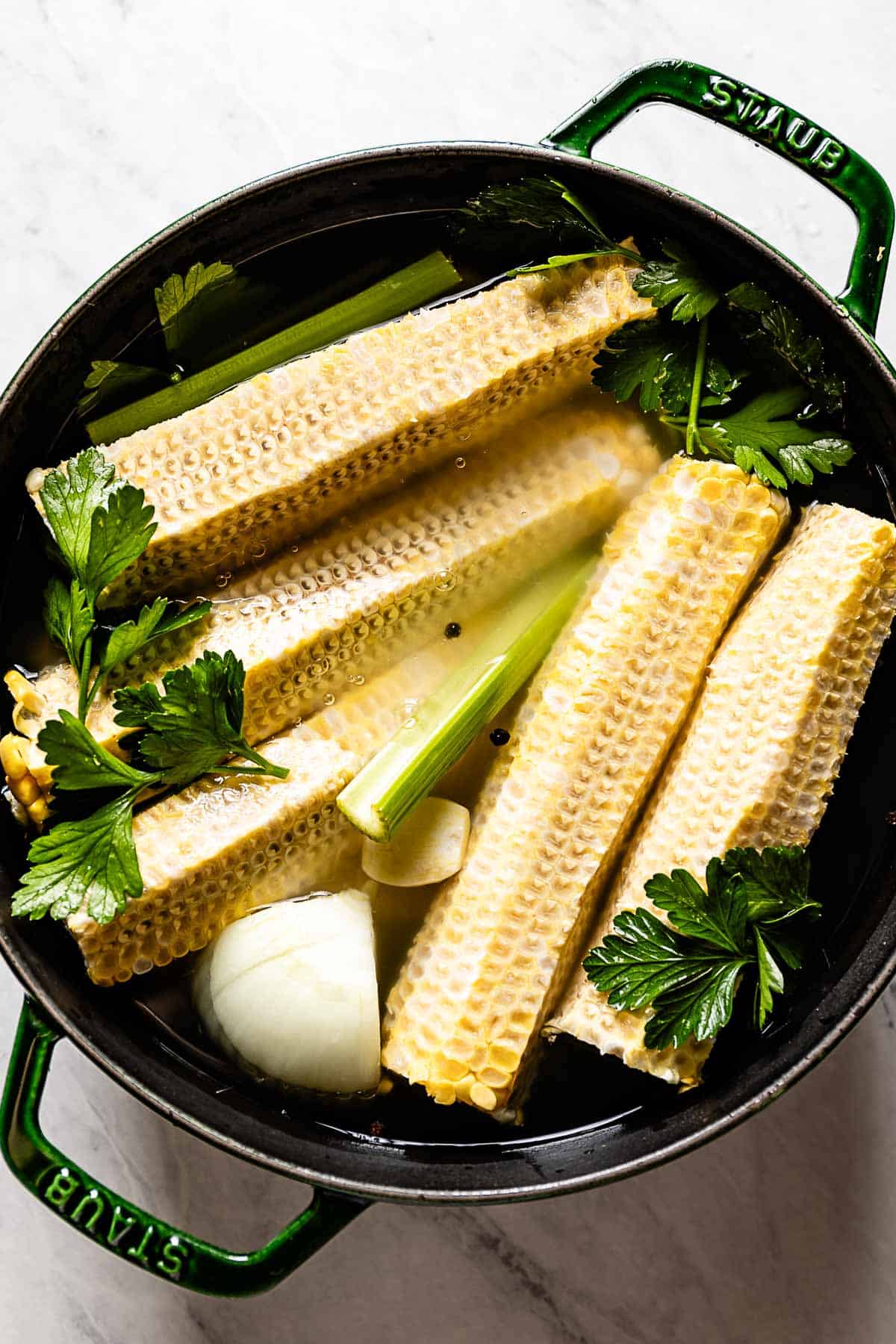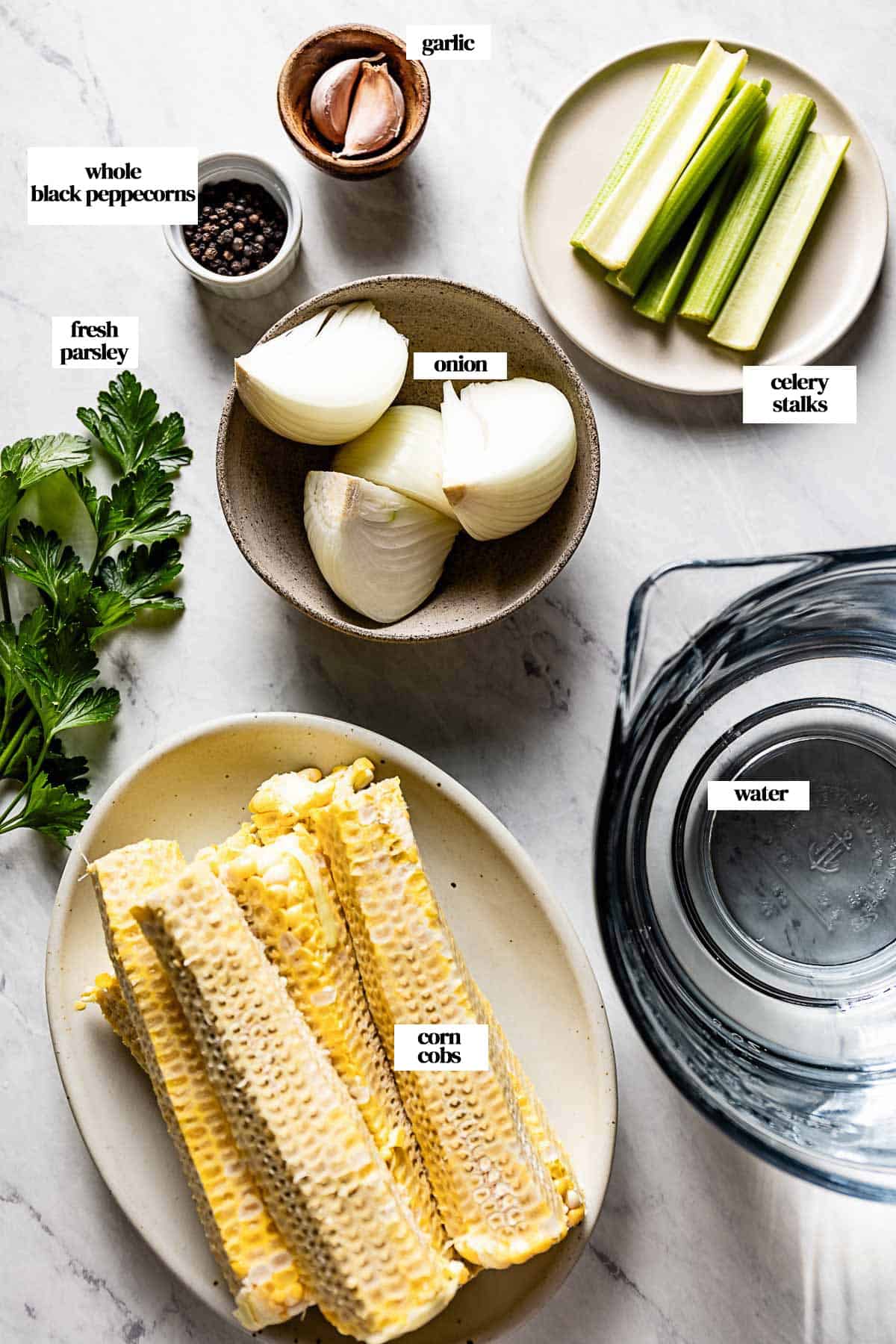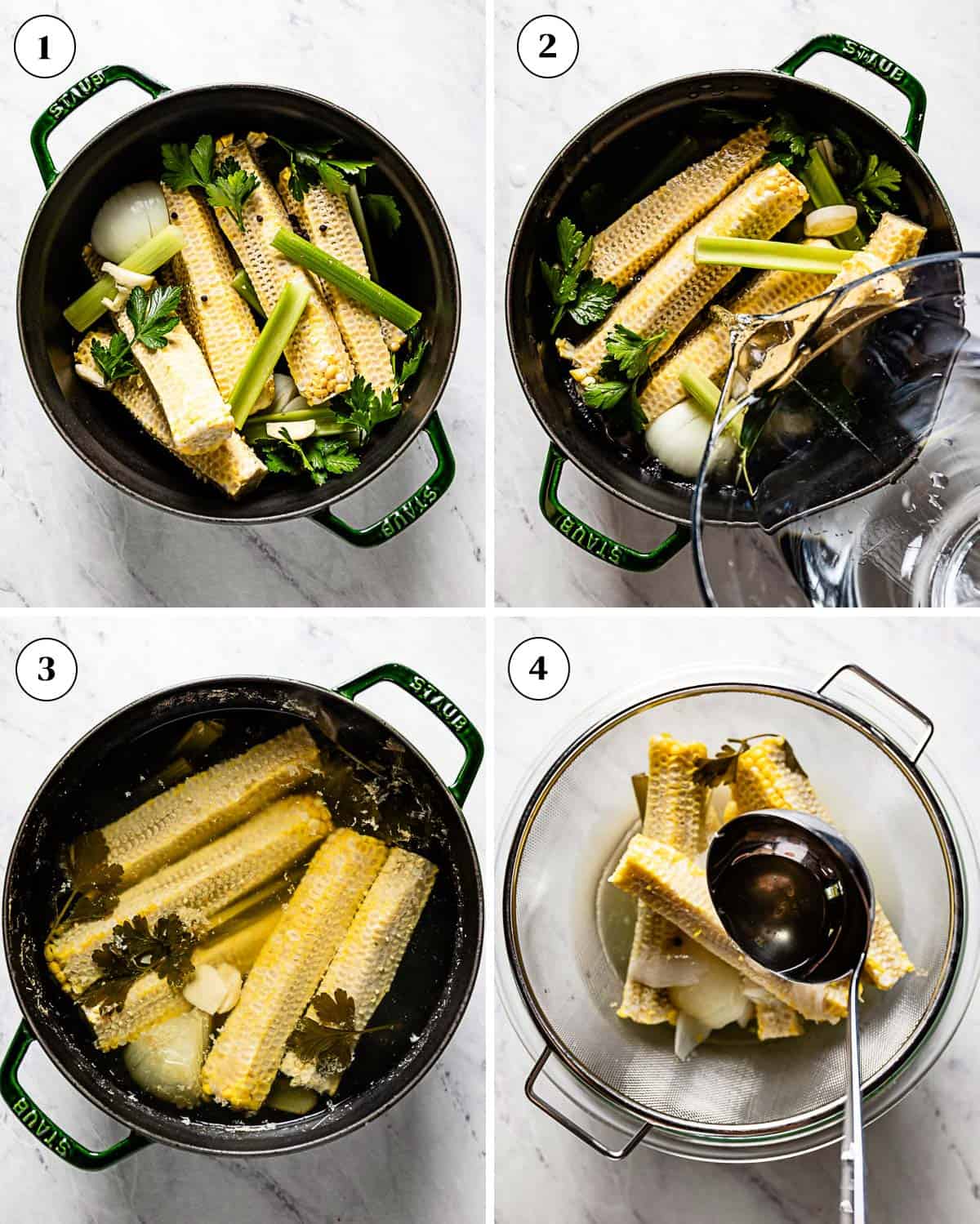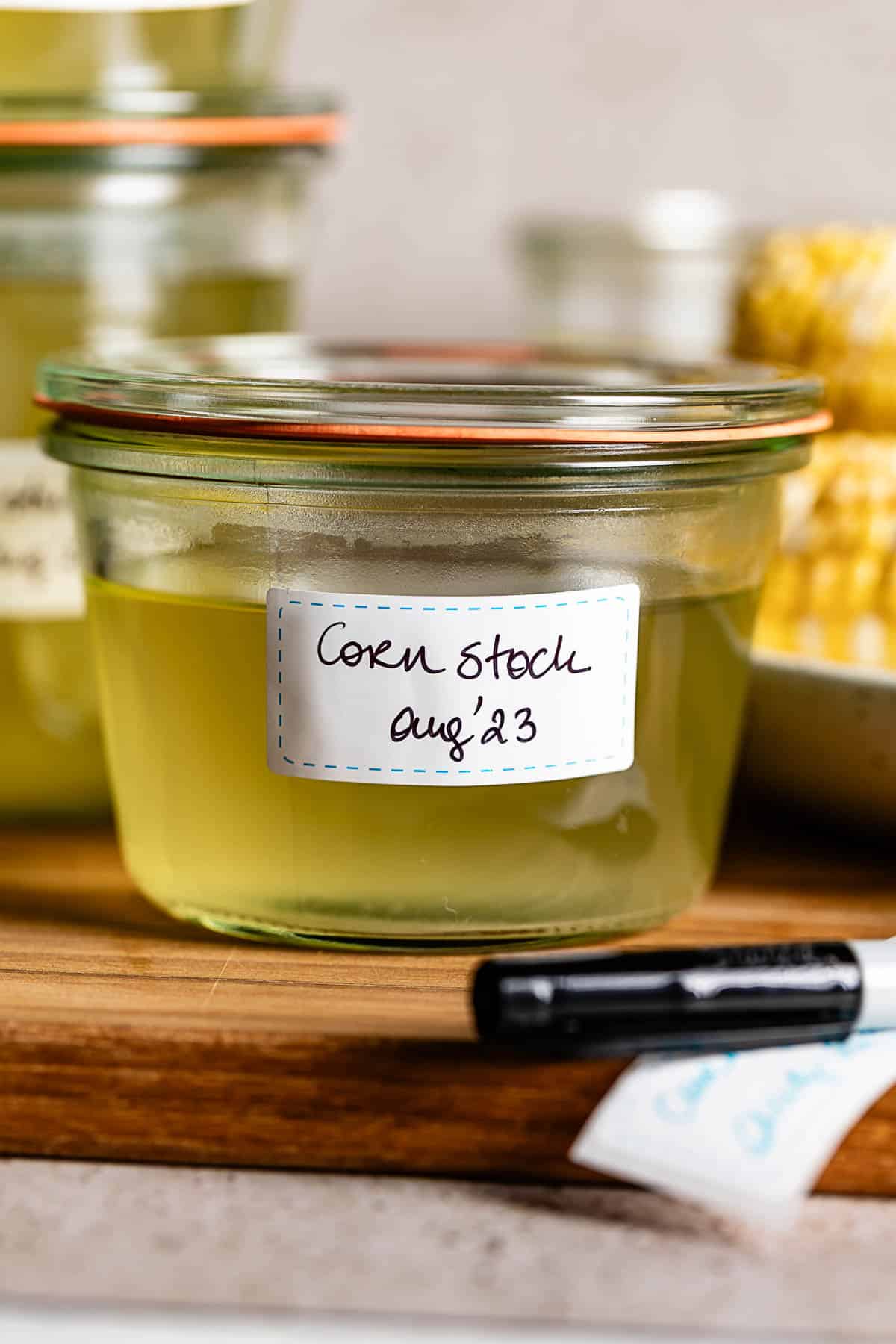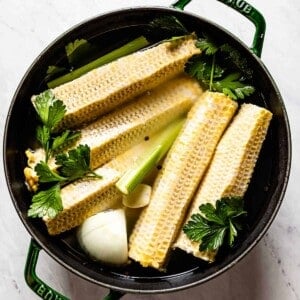Ingredients You’ll Need
This delicious corn cob stock recipe uses only six simple ingredients to produce an all-purpose stock perfect for countless kinds of dishes.
Corn cobs: The best way to get deliciously sweet, nutritious, and robust corn stock is to use fresh corn on the cob with no blemishes. Needless to say, corn husks, silks, and kernels should be removed. If you can get your hands on it, I recommend buying Non-GMO corn. Celery stalks Yellow onion: I love using yellow onion in this recipe because of its mild, balanced taste. However, you may also use white onions if you’d like your stock to have a slightly more potent, intense flavor. Fresh garlic cloves Fresh parsley leaves Whole black peppercorns
How to Make Corn Stock?
Learning how to make corn broth is an easy way to give your favorite recipes tantalizingly sweet, fresh undertones. These hassle-free instructions will have your stock ready to use in just five steps.
Carrot: You only need one small carrot stalk to add sweet, earthy notes to your corn broth. Be careful not to add too many carrots, though, as this ingredient may take over your recipe’s more nuanced, delicate flavors. Fresh herbs: To give your stock recipe a hint of bright, herbaceous flavor, I recommend adding a few sprigs of fresh thyme, rosemary, or a bay leaf. Spices: A few extra spices are all this corn broth recipe needs to lend its sweet overtones a touch of bold, fresh taste. Cumin seeds will add rich, warm tones to your stock, while coriander seeds are perfect for giving your mix a spicy, slightly citrusy edge. You may add a few bay leaves, too, for a somewhat more herby flavor. Salt: I didn’t add salt to my corn broth to ensure I had more control over my prepared recipes’ seasoning balance. However, you may add salt to your mixture according to personal preference. Parmesan rind: This nutty, bold ingredient is a perfect addition to homemade corn stock, especially if you are using your stock to make creamy risotto or corn chowder.
How to Store and Freeze Corn Cob Stock?
Homemade corn broth is one of the most storage-friendly recipes in my recipe book. Store your stock in airtight containers, such as Mason jars or weck jars, to ensure it remains as fresh and flavorful as possible.
To store: Let the corn stock cool for an hour or so and then divide it amongst airtight containers or jars and store it in the fridge for up to 5 days. To freeze: For even longer storage, you may freeze your corn stock by letting it cool in airtight jars (such as Weck jars (affiliate link), closing the containers, and placing it in the freezer for up to three months.
How to Use Corn Stock in Recipes?
Versatile and oh-so-easy to make, this corn stock recipe comes in handy for dozens of mouthwatering dishes. Below, you’ll find just a few of my go-to stock-based recipes.
Soups, stews, and chili bases: Infuse your soup recipes with next-level flavors by transforming them into corn cob soup. I love adding the sweet notes of corn stock to my creamy and piquant Mexican Corn Soup—my favorite alternative to corn chowder. Or, for a heartier meal, use corn broth as a base for protein-packed chili recipes, like my Quinoa Chili or White Chicken Chili. For cooking whole grains: You’ll never have to worry about bland grains again when you prepare them in this corn broth recipe. If you’re a quinoa fanatic like I am, you’ll love using corn stock in place of water to make basic cooked quinoa or to liven it up with a Mexican Quinoa version. You can also make show-stopping sides out of simple ingredients with dishes like Bulgur Wheat, Wild Rice, and Corn Risotto. Cornbread and corn cakes: What’s cornbread without golden-sweet corn flavor in each bite? This corn broth makes an excellent addition to classic side dishes like Cornbread Muffins and Corn Cakes. Polenta and grits: Mild, creamy, and endlessly customizable, polenta and grits taste out of this world when prepared with corn stock. If you want a vegetarian recipe that will stun your dinner guests with a five-star taste, this Creamy Polenta combines roasted mushrooms, toasted walnuts, and creamy blue cheese for an out-of-this-world flavor. Poaching liquid: Corn stock makes an incomparably flavorful poaching liquid when preparing meats such as fish (especially salmon!) or chicken. Sip on it: Drinking pure corn stock is a delicious and easy way to pack nutrients into every sip.
Other Corn Recipes You Might Also Like
Few recipes match a stock of corn’s subtle sweetness and complex flavor. If you’re craving more soft, buttery corn recipes, these dishes will fill your table for days.
More corn, no problem: The recipe below only requires six empty corn cobs. However, if you have more ears of corn, feel free to add them to your mixture with enough water to cover them by an inch. Let it simmer: After coming to a boil, let your corn cob soup stock simmer for at least an hour (and no longer than two hours!). This time allows the veggies to release their natural flavors into the liquid without boiling away any nutrients or diminishing their taste. Strain: Because of all the vegetable juices released into corn stock, this recipe might produce a cloudy liquid. If you prefer a clear stock, layer a cheesecloth at the bottom of your fine-mesh strainer before draining your broth. Label and date: The key to ensuring that your corn cob stock remains as bright and flavorful as possible is using it while it’s fresh. I recommend labeling and dating your stored broth so that you know when to use it. Remember, broth stored in the fridge should be used within five days, while frozen corn broth should be used within three months.
Street Corn Pasta Salad Esquites Air Fryer Elotes Black Bean and Corn Salad
If you try this Corn Stock recipe, please take a minute to rate the recipe and leave a comment below. It is a great help to others who are thinking of making the recipe. And if you took some pictures, be sure to share them on Instagram using #foolproofeats so I can share them on my stories.

